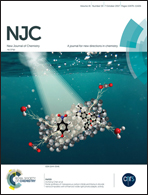Development of N and S heteroatom co-doped stable dual emitting carbon ink in aqueous media for sensing applications†
Abstract
In recent times great attention has been given to the synthesis of fluorescent carbon nanomaterials with high quantum yield and multicolor eye catching fluorescence emission for various applications. In this work, a facile hydrothermal method has been adapted for the synthesis of nitrogen and sulfur co-doped water soluble highly fluorescent carbon ink with a dual emission zone. Incorporation of heteroatoms induces different surface states leading to excellent tunable fluorescence properties. The synthesized carbon material exhibited a maximum quantum yield of 52% and 14% for blue emission at 440 nm and green emission at 510 nm, respectively. The observed fluorescence properties were sensitive towards toxic Hg2+ ions in water with a lower detection limit of 5 nM. The (N,S)-CNPs are able to detect Hg2+ at a much lower level compared to the maximum concentration allowed in normal drinking water, set by the Environmental Protection Agency (USA). In addition, the emission characteristics of the synthesized carbon are very sensitive to the pH of the medium as well.



 Please wait while we load your content...
Please wait while we load your content...